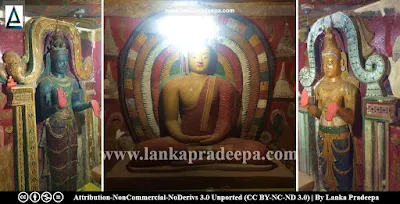
Ganewatta Tempita Viharaya, also known as Ganewaththa Purana Bodhimalu Viharaya (Sinhala: ගණේවත්ත ටැම්පිට විහාරය, ගණේවත්ත පුරාණ බෝධිමලු විහාරය), is a Buddhist temple situated in Divulapitiya in Gampaha District, Sri Lanka.
History
According to the folklore, Ganinnanselas who were considered persons with the appearance of Buddhist monks lived in this temple at the beginning of its establishment. The Tempita Viharaya shrine of this temple is said to have been built during the latter part of the Kandyan Period, most probably in the 19th century.
Tempita Viharaya
Tempita Viharas (the temples on pillars) were a popular aspect of many Buddhist temples during the Kandyan period. These structures were usually built on a wooden platform resting on bare stone pillars or stumps which are about 1-4 feet tall. The roof is generally made of timber and held by wooden stumps. The walls are usually made of wattle and daub and they form the main enclosed shrine room containing the Buddhist sculptures and murals belonging to the Kandyan style. Some Tempita Viharas have narrow verandas and ambulatories circulating the main enclosed space. The construction of these buildings started in the 17th century and lasted until the end of the 19th century (Wijayawardhana, 2010).
Ganewatta Tempita Viharaya
The Tempita Viharaya is the main aspect of this temple with archaeological value. It is a rectangular building and has been built upon 9 granite pillars about 3 ft. 2 inches tall (Chandrasoma, 2013). The four-sided roof with a short ridge at the top is borne by supportive wooden pillars as well as by the wattle walls. The roof has been paved with flat clay tiles (Maliga Ulu).
The building is 15 ft. 8 inches long and 9 ft. 3 inches wide and can be accessed through a wooden flight of steps (Chandrasoma, 2013). Inside the shrine is a seated statue of Buddha accompanied by two images of Sariputta (left) and Moggallana (right), the two chief disciples of Gautama Buddha. Two standing statues, probably the statues of God Visnu and Kataragama, are found facing each other on both the left and right walls. On the inner side of the entrance wall, two figures of Buddhist monks named Kelewitimulle Hamuduruwo and Pasyale Hamuduruwo are found (Chandrasoma, 2013).
The inner walls of the shrine have been decorated with paintings depicting Buddhist themes. The Solosmasthana (the 16 most sacred shrines in Sri Lanka), and Jataka tales (stories that tell about the previous 550 lives of the Buddha) such as Daham Sonda, and Kihiranga are found among them. According to the view of academicians, these paintings belong to the period between the latter part of the Kandyan era and the beginning of the modern period (Chandrasoma, 2013).
A special feature of this Tempita Viharaya is that it does not have an outer ambulatory. Also, there are no paintings on the outer side of the shrine. However, some fragments of old paintings depicting the top part of two door-keepers are found exposed on the front wall where its outer lime plaster crumbled off (Chandrasoma, 2013). A small open hall has been built in front of the Tempita shrine recently.

 .
.References
1) Chandrasoma, S., 2013. Gampaha Distrikkaye Tempita Vihara (In Sinhala). Department of Archaeology (Sri Lanka). Colombo. ISBN: 978-955-9159-85-8. pp.50-56.
2) Wijayawardhana, K., 2010. Sri Lankawe Tampita Vihara (In Sinhala). Dayawansa Jayakody & Company. Colombo. ISBN: 978-955-551-752-2. p. 12.
Location Map
This page was last updated on 8 April 2023


